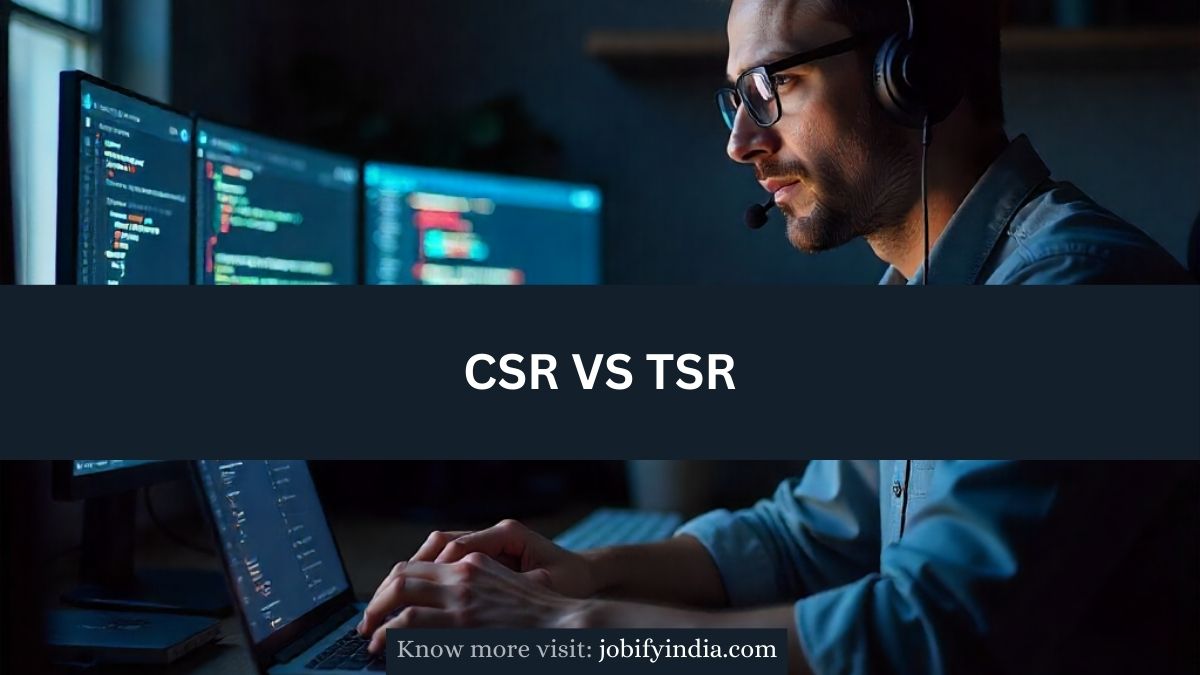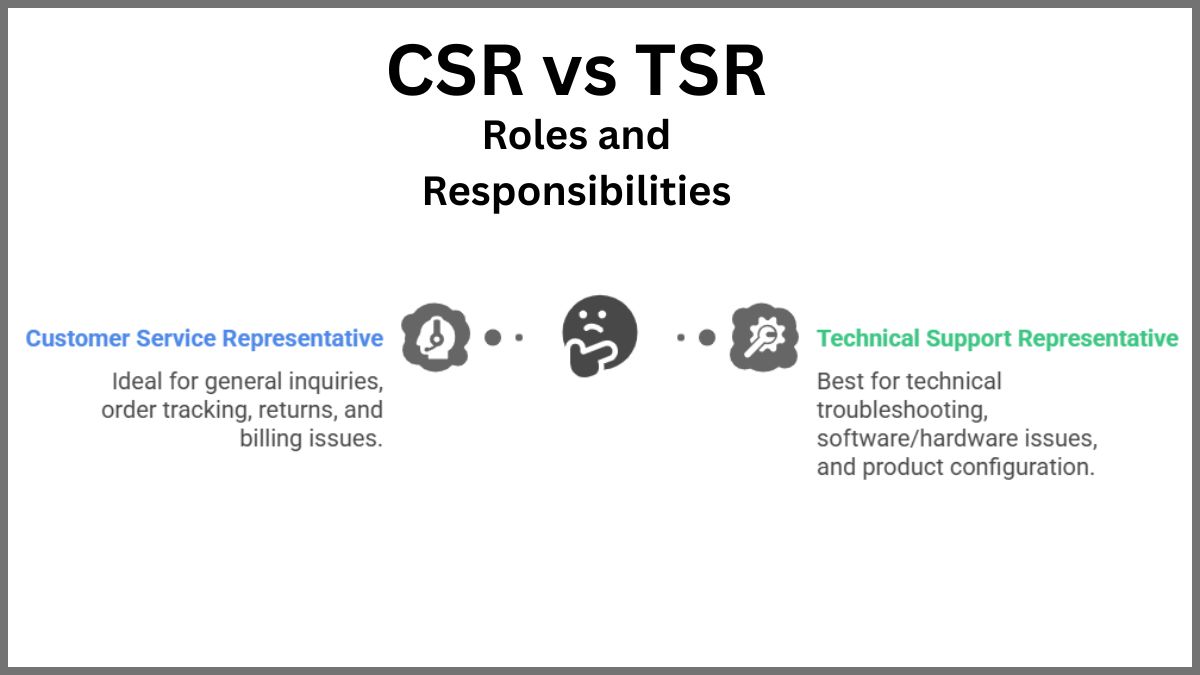In today’s digital world, great customer support can make or break a business. Whether you’re calling a service line, chatting online, or sending an email, there’s usually someone on the other end ready to help. But when it comes to CSR vs TSR, do you know who’s handling your issue and what their roles really mean?
Two of the most common roles in customer support are Customer Service Representatives (CSRs) and Technical Support Representatives (TSRs). While they may seem similar at first glance, these roles are quite different when you dig a little deeper.
Let’s break it down in a simple, easy-to-understand way so you’ll never confuse the two again.
What Exactly Does a CSR Do?
Imagine you ordered a product online, but it didn’t arrive on time. Or maybe you received the wrong item. In both cases, your first instinct would probably be to contact customer support.
The person who picks up the phone or responds to your message is likely a Customer Service Representative (CSR).
The Core Responsibilities of a CSR
CSRs are the friendly faces (or voices) of a company. Their primary job is to ensure that customers are happy before, during, and after a purchase. Here’s what they typically handle:
- Answering general questions about products or services
- Helping customers place or track orders
- Processing returns, exchanges, or refunds
- Dealing with billing or account issues
- Offering product recommendations
Think of them as problem-solvers and company ambassadors. They handle a wide range of issues, but usually don’t dive into technical problems — that’s where TSRs come in.
So, What About TSRs?
Let’s say you just bought a new smart TV, but you can’t get it to connect to the Wi-Fi. You try all the tricks you know, but nothing works. That’s when the Technical Support Representative (TSR) steps in.
The Core Responsibilities of a TSR
TSRs are the experts in troubleshooting and solving more complex, technical issues. Here’s what they handle:
- Helping customers install, configure, or use tech products
- Troubleshooting software or hardware issues
- Providing step-by-step solutions to fix errors or bugs
- Escalating more complicated problems to higher-level tech teams
They might not be as involved in general customer service queries, but when tech gets tricky, TSRs are your go-to pros.
Key Differences Between CSRs and TSRs
While both roles involve customer interaction, their focus areas are different. Here are the key differences in a nutshell:
- Nature of support: CSRs offer general customer help; TSRs handle technical issues.
- Required knowledge: CSRs need product and company knowledge; TSRs need technical know-how.
- Training: CSR training emphasizes communication and process; TSR training focuses on technology and troubleshooting.
- Tools used: CSRs use CRM tools and standard support platforms; TSRs may use diagnostic tools and technical systems.
Still feeling unsure about how that looks in real life? Let’s look at a quick story.
A Real-World Example
Meet Sarah. She just bought a new smartphone from an online store. But after a few days, she notices she was charged twice.
She calls customer support and speaks with Mike, a CSR. Mike quickly looks at her order history, apologizes for the error, and helps process a refund.
Later that day, Sarah realizes her phone won’t connect to the app designed to sync with her fitness tracker. This time, she gets transferred to Rachel, a TSR. Rachel walks her through the steps to fix a Bluetooth setting, and voila — all is well.
Both Mike and Rachel worked in support — but they had different kinds of expertise.
Why Both Roles Matter More Than Ever
With so much business happening online these days, strong customer support can make a big impact. Here’s why companies need both CSRs and TSRs:
- Better customer experience: CSRs ensure smooth sales and everyday interactions.
- Faster issue resolution: TSRs quickly solve tech problems, reducing frustration and downtime.
- Stronger brand loyalty: When customers feel heard and helped — regardless of the issue — they’re more likely to stick around.
Having both roles ensures that every customer receives the right kind of help from the right kind of expert.
Overlapping Skills: What CSRs and TSRs Have in Common
Although their day-to-day tasks may differ, CSRs and TSRs share many similar skills:
- Great communication: Explaining things clearly is key in both roles.
- Patience and empathy: Whether someone is upset about a bill or stressed over a broken device, a calm and caring attitude goes a long way.
- Problem-solving: Both roles require quick thinking and creative solutions.
- Multitasking: Juggling calls, emails, and multiple systems is all in a day’s work.
In many companies, these shared skills even allow support agents to cross over between roles over time.
How Companies Choose Between CSR and TSR Roles
When deciding which roles to fill, companies typically base the decision on the products or services they offer. For example:
- Retail companies mainly need CSRs to handle orders, refunds, or general queries.
- Tech companies often require more support from TSRs to manage hardware or software issues.
- Hybrid businesses (like e-commerce platforms with tech products) will usually employ both.
For job seekers, it’s all about what interests you. If you love helping people and solving everyday problems, a CSR role might be for you. If you’re a tech whiz who enjoys digging into systems to fix things, TSR could be your calling.
Final Thoughts: CSR vs TSR — Two Sides of the Same Support Coin
At the end of the day, both CSRs and TSRs play crucial roles in creating a seamless customer experience. They’re the unsung heroes behind every smooth shopping experience, app install, or technical fix.
Understanding the difference between the two not only helps businesses build stronger teams but also makes it easier for customers to get the right kind of help — faster.
So the next time you’re on a support call, see if you can guess who you’re talking to: a helpful CSR smoothing out your order issue, or a wise TSR guiding you through a technical maze.
Either way, they’ve got your back — and that’s what great customer support is all about.
Looking to build a stronger support team? Make sure you’re hiring the right mix of CSRs and TSRs. After all, happy customers are loyal customers — and that’s the real bottom line.
Frequently Asked Questions
What is the main difference between CSR and TSR?
The main difference lies in focus. CSRs handle customer service tasks like inquiries and orders, while TSRs handle technical troubleshooting.
Can a CSR become a TSR?
Yes, with the right technical training and a desire to learn, many CSRs can move into TSR roles over time.
Do all companies need both CSRs and TSRs?
Not necessarily. It depends on what type of products or services they offer. Tech-heavy companies often need TSRs, while retail-focused businesses may rely more on CSRs.
Which position pays more: CSR or TSR?
TSRs often earn slightly more because the job usually requires more technical knowledge and specialization.
Which role is right for me?
If you enjoy helping people and working with customers, CSR might be a great fit. If you love solving tech problems, go for a TSR role.
Remember, both jobs are important, rewarding — and essential to great customer support.





